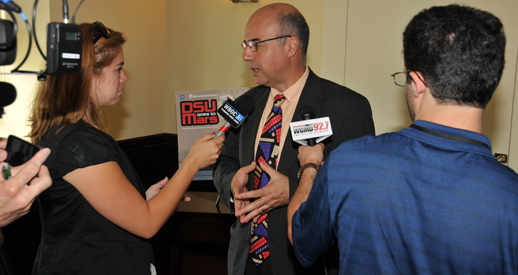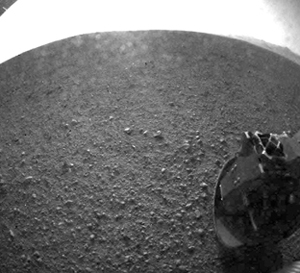
DSU’s Dr. Melikechi Prepares for NASA Work after Curiosity Landing
NASA’s Curiosity Rover has landed on Mars.
Now DSU’s Dr. Noureddine Melikechi will soon contribute his optics expertise as part of the Curiosity ChemCam Team and assist the space agency in analyzing the data that comes back from Mars through the rover.
Culminating a 367 million-mile and 36-week flight from earth, the Curiosity Rover was lowered gently by ropes from a rocket backpack onto the Mars surface inside its Gale Crater at 1:32 a.m. EST on Monday, Aug. 6.
Dr. Melikechi, who is also the dean of the College of Mathematics, Natural Sciences and Technology as well as the University’s vice president of research, showed his excitement during a morning press briefing with local media on Aug. 6.
“Imagine, you build something that you can’t test, send it 570 million kilometers, and it works for the first time,” said Dr. Melikechi, referring to the complex landing technique. “I am so proud to be a part of this mission, which includes about 300 scientists – of which I am one – and thousands of engineers.”
|
|
He and two graduate assistants, Alissa Mezzacappa and Angela Lundberg, are part of the mission’s ChemCam Team. The ChemCam (Chemistry and Camera suite), one of 10 instruments on the Curiosity, will be used to study the soil and rocks at each place Curiosity stops.
The ChemCam will shoot an infrared laser – more than a million watts of power – at rock surfaces on the planet. The resulting light will be read by the unit’s spectrometer, which is expected to provide new information concerning the rock composition of the planet.
The ChemCam utilizes a technology called laser-induced spectroscopy, which has been used in determine the composition of objects in extreme environments such as nuclear reactors and on the sea floor. However, this is the first time the technology has been used in space exploration.
After the Curiosity does some preliminary checks and scientific work during its early days on the planet, the ChemCam will shoot its first laser blasts in mid-August, Dr. Melikechi said.
The primary goal of the Curiosity mission is to study whether the Gale Crater area of Mars has evidence of past or present habitable environments. Dr. Melikechi said the mission will be looking for the past or present existence of liquid water, the chemical elements required to sustain life, and a source of energy, all necessary elements for habitability.
“It is my hope that we will see something that no one expects,” Dr. Melikechi said.
Dr. Melikechi will travel later this month and again in September to NASA’s Jet Propulsion Laboratory in California to receive the first data from the ChemCam unit.
|
|
State Sen. Brian Bushweller, in attendance at the press briefing, called the landing “a big day for the nation and a big day for DSU.”
“Standing shoulder to shoulder with all the others involved in the mission is DSU and its Optics Program,” Sen. Bushweller said. “DSU has given the state something to be very proud of.”
This collaboration with NASA on the Mars mission is the latest accomplishment in the career of Dr. Melikechi and in the development of the Optics Program at DSU. Beginning with the establishment in 1998 of the Applied Optics Center on campus, through Dr. Melikechi’s leadership the program has attracted two $5 million research grants from the National Science Foundation in 2006 and from NASA in 2009.
The two grants resulted in the establishment of a Center for Research in Education and Optical Sciences and its Applications, and the Center for Applied Optics in Space Sciences. That expansion in the Optics Program infrastructure also led to the creation of master and doctoral optics degree programs, the creation of the University first-ever intellectual property – a laser-based diagnostic device to be used in hospitals – and the attraction of $10 million in state funding for the future construction of an optics facility on campus.


 Angela Lundberg is one of two graduate assistants who will work with Dr. Melikechi in the analysis of the Mars data.
Angela Lundberg is one of two graduate assistants who will work with Dr. Melikechi in the analysis of the Mars data. One of the first images sent to earth from Curiosity shortly after its landing on Aug. 6.
One of the first images sent to earth from Curiosity shortly after its landing on Aug. 6.